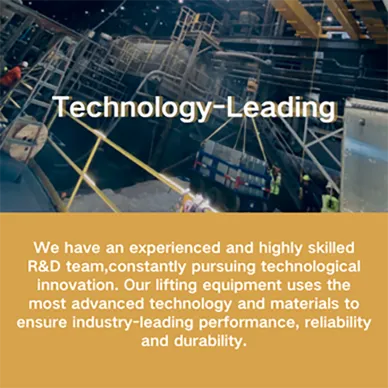hoist magnet
Understanding Hoist Magnets The Essential Tool for Heavy Lifting
In the realm of industrial lifting equipment, hoist magnets have garnered significant attention due to their ability to lift heavy ferrous materials with ease. These powerful devices, often used in factories, construction sites, and scrap yards, play a crucial role in enhancing efficiency and safety in material handling. In this article, we will explore the functionality, types, advantages, and applications of hoist magnets.
What is a Hoist Magnet?
A hoist magnet is a lifting device that uses magnetic force to securely lift and move metal objects. Typically powered by electricity, hoist magnets can be classified into two main types permanent magnets and electromagnetic hoist magnets.
- Permanent Magnet Hoists use strong permanent magnets made from materials like neodymium or samarium-cobalt. These magnets provide a constant magnetic force, making them ideal for applications where the load is not frequently released.
- Electromagnetic Hoists, on the other hand, create a magnetic field when electric current flows through coils. This type allows for greater control, enabling operators to turn the magnet on and off as needed, which is essential in applications where load handling varies.
How Do Hoist Magnets Work?
The operation of hoist magnets is relatively straightforward. In permanent magnet hoists, the magnet’s inherent magnetic field attracts ferrous materials. In electromagnetic hoists, when electricity is supplied to the coils, a magnetic field is generated, allowing the magnet to lift and hold metal objects securely. The intensity of the magnetic field can be varied based on the amount of current supplied, providing greater versatility in handling different types of loads.
Hoist magnets are typically mounted on cranes or hoisting frames, enabling them to move heavy loads vertically and horizontally. Operators can use joysticks or remote controls to maneuver the crane, ensuring precise placement of heavy objects.
Advantages of Hoist Magnets
The use of hoist magnets offers several key advantages
1. Efficiency Hoist magnets significantly speed up the lifting process. Unlike traditional methods, which often require slings or chains, magnets can quickly engage and lift multiple items in a single maneuver.
hoist magnet

2. Safety The risk of accidents associated with manual lifting methods is greatly reduced. Since hoist magnets securely grip items, there is a lower chance of slippage or dropping loads.
3. Versatility Hoist magnets can lift a variety of steel objects, from sheets and plates to scrap metal, making them suitable for different industries, including manufacturing and recycling.
4. Reduced Wear on Equipment Since hoist magnets require no physical contact with the load (in the case of permanent magnets), there is less wear and tear on lifting equipment, leading to lower maintenance costs over time.
Applications of Hoist Magnets
Hoist magnets find applications in various sectors, including
- Manufacturing In assembly lines, hoist magnets are used to lift heavy parts and components, allowing for a streamlined production process.
- Scrap Yards These magnets are essential for lifting and transporting scrap metal, where they can efficiently collect and move large quantities of ferrous materials.
- Construction Hoist magnets assist in the placement of steel beams and other structural components, facilitating quicker assembly and construction times.
- Warehouses In storage facilities, hoist magnets help arrange and manage heavy loads, enhancing overall workplace efficiency.
Conclusion
Hoist magnets represent a significant advancement in lifting technology, offering efficiency, safety, and versatility for a wide range of industrial applications. As industries continue to evolve and demand greater productivity, the importance of these powerful tools will only grow. For companies looking to streamline their material handling processes, investing in high-quality hoist magnets can provide dramatic improvements in operational efficiency and safety, positioning them for success in a competitive marketplace.
-
Dawei Hand Pallet Truck 1200mm, 2000–5000 KGS Heavy-DutyNewsNov.17,2025
-
Dawei Hand Pallet Truck, Fork Length 1200mm, 2000–5000kgNewsNov.17,2025
-
Large Equipment Movers – Safe, Insured & On-Time ServiceNewsNov.17,2025
-
Machine Moving Dollies | Heavy-Duty, Low-Profile, SafeNewsNov.17,2025
-
Permanent Lifting Magnet - Heavy-Duty, Safe, Quick ReleaseNewsNov.11,2025
-
PML 1000 Lifting Magnet - Heavy-Duty, Safe, No PowerNewsNov.11,2025
-
Large Equipment Movers: Safe, Fast, Certified ProsNewsNov.11,2025
